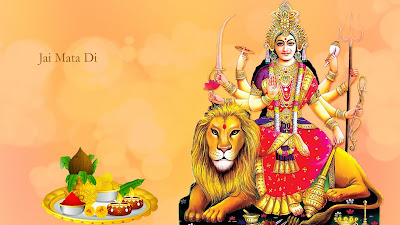The Hindu festival of Navratri is celebrated twice a year. The first Navratri of the year is known as Chaitra Navratra, as it falls in March-April. The second Navratri is held in October-November, which coincides Durga Puja. The nights of Navratri are devoted to the reverence of Goddess Durga, who is worshipped in many forms. Prayers are offered to Goddess Durga, as she is considered the manifestation of the absolute energy that pervades the Universe. All through the nine days, the devotees would chant mantras, sing songs and bhajans in the praise of the deity. Fasting on Navratri is considered auspicious. To celebrate the festival, a number of pujas are conducted all through the nine days. Go through the following lines to get the vidhi (procedure) of Navratri puja.
Also View: Mata Rani Navroop (9 Roop of Mata Rani)
Navaratri Puja Vidhi
Certain items are required to perform the Navratri puja. These may include the idol or picture of Goddess Durga, Durga Sapthashati book, water in Kalash (pitcher), fresh washed mango leaves, one coconut, roli (red color for tilak), moli (red sacred thread), chawal (rice), paan (betel leaves), supari (beetle nuts), cloves, cardamom, kumkum (vermilion) and gulal. You will also need few incense sticks, a deep and matchstick. The flowers used for Navratri puja may include rose, lotus and red hibiscus. Stalks of Bilwa (bael) leaves are also used for the puja. You may offer fresh pomegranate and sweets such as laddoo and peda, as prasad. You will require a Panchpatra containing spoon and water, bael leaves. Take a mat as well, to sit.
In order to perform the puja, take bath in the morning and wear laundered clothes. Then, fill the kalash with water and place mango leaves on its mouth. Place a coconut inside the kalash. Now, tie moli on the neck of the pitcher. Place the idol or picture of Maa Durga at your puja room and then worship the deity with roli, rice, flowers, balepatra, kumkum and gulal. Thereafter, you may add burning coal to a clay pot and pour ghee (clarified butter) over it. Offer a small piece of the sweetmeat to the fire. Keep adding ghee to the fire at regular intervals. Make sure that you maintain the light throughout your puja. Once the puja is over, fold your hands and encircle the flame for three times. Light the incense sticks and deep and perform the aarti. You may sing arti song while doing the aarti. You may chant Durga Saptashati or Devi Kavach or ask a pundit to do it, to conclude the puja.
Navratri Fast
The Navratri fast is observed from the first day to the ninth day. Some devotees only observe fast during three days i.e., first fast during any one of the first three days and second fast during any one of the next three and last in any one of final three days. Some people confine to milk and fruits during the nine days. Most devotees take a single meal during the day. Non-vegetarian & tamsik (onion, garlic, etc) food is totally avoided.
Navratri Dishes
- Kuttu/Singhara Poori
- Kuttu/Singhara Pakori
- Fried Aloo
- Fruit Chaat
- Sabudana Khichadi
- Makhane Ki Subzi
- Sawank Ke Chawal
- Dahi Pudine Wale Aloo
- Makhane Ki Sabzi
- Shakarkandi Ki Chaat
- Sabudana Papad
- Aloo Raita
- Banana Chips
- Fruits/Fruit Juices
- Sabudana Khir
Navratri Wallpapers






























